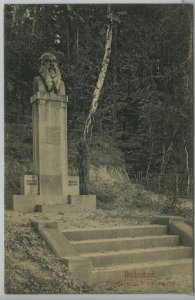
Jahn plateau

| Popis |
In 1906 the Podmokelsky beautifying association (Anpflanzungs- und Verschönerungs-Verein) set up a new Teufel gorge to the new restaurant on Pastýřská stěna. It is a steep valley rising to the summit of the Shepherd's Wall from the southern portal of the railway tunnel. The name Teufel's Gorge (Teufelsschlucht) is derived from the surname of the former owner of the land. The ascent begins at house no. 329 (today Čs. Armády street), where was a restaurant with long stone terraces allowing the view over the railway line to the opposite castle. From this place , the path leads to the top of the Shepherd's Wall. About half the height turns to the lookout terrace called Jahn plateau (Jahnplatte). The title reminds the founder of the German gymnastic movement Friedrich Ludwig Jahn (1778-1852). In the 130th anniversary of his birth in 1908, the Deutscher Turnverein, a German gymnasium, unveiled a bronze bust on a high tetrahedral pedestal. In 1933, the plinth was supplemented by the names of the Turner fallen during the First World War. The bronze bust was given in 1940 for war and melted. During the construction of the Prague-Dresden railway in the years 1847-1850, a tunnel for two tracks with a length of 279.35 m was broken through the Pastýř Wall between Podmokly (today Děčín hl. N.) And Přípeř. The railway line from Podmokely to the state border near Dolní Žleb was built and managed by the company of the Royal Saxon State Railway, which also owned half of the railway stations in Podmokly. The original Gothic portals still adorn the tunnel facade. The northern portal is arched, the southern one angled. The tunnel forms a whole with the neighboring tunnel under the Red Hill, with neither of the two tunnels facing the same. Due to the higher quality of the local sandstone, the tunnel is only embossed in the rock and not walled up. The track was inaugurated on April 6, 1851 by one dormitory. After World War II, the tunnel was deepened and electrified. |





